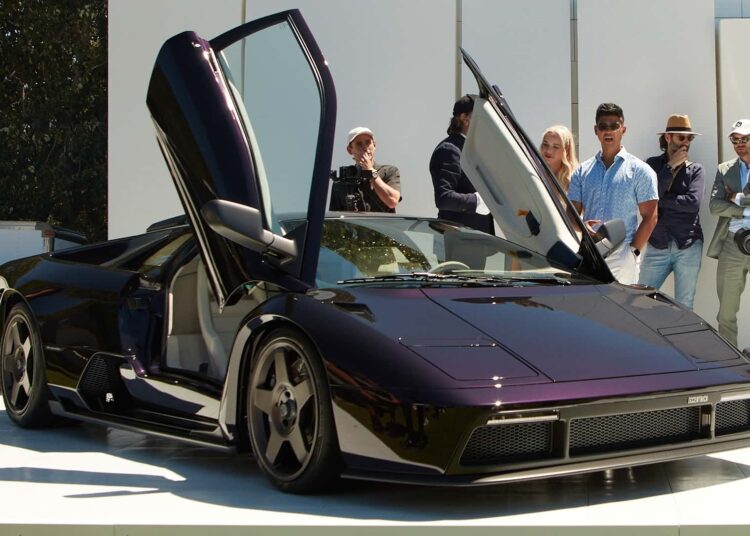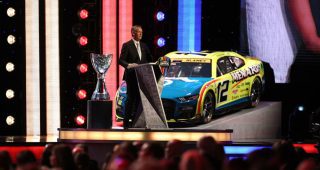The Eccentrica stand at The Quail, A Motorsports Gathering, had something I hadn’t held in my hands in years. Not the gated shifter of a first-series Lamborghini Diablo, but a cassette mixtape. Piles of “Mixed by Eccentrica Vol. II” tapes in fresh jewel cases were painstakingly arranged at the stand where the Diablo-based Eccentrica V12 made its US debut during Monterey Car Week.
Also present: Maurizio Reggiani, who recently retired as Lamborghini’s Chief Technical Officer after nearly 30 years with the automaker. Rather than kick back and relax, Reggiani dove right into developing the Diablo restomod you see here—a running, driving love letter to the 1990s. Motor1 spoke with the supercar engineer to understand what went into making this modernized V-12 devil.
Eccentrica
“I started at Lamborghini in 1995,” Reggiani said. “That means I started to work on the Diablo SE and SV.” The Eccentrica V12 is based on a first-series Diablo, built from 1991 to 1994.
“This car was not part of my life, and now it’s like I’m closing the entire circle of my career in Lamborghini,” Reggiani said.
Like most sports car and supercar restomods, the goal for Eccentrica was to improve the driving and functionality of the original Diablo while retaining its classic style and pure 1990s driving experience.
“We tried to solve things with technology, without introducing a huge quantity of electronics,” Reggiani said.

Eccentrica
The 5.7-liter V-12 engine now sports single-coil ignition, throttle-by-wire, and a redesigned exhaust. It sends 500 horsepower and more than 440 pound-feet of torque to the rear wheels via a six-speed manual transmission with shorter gearing than the original five-speed. The six-speed gearbox, Reggiani says, was custom-made for Eccentrica—an expensive proposition, especially given the company only intends to build 19 examples of this Diablo restomod.
Electronically-controlled dampers and modern engine management allowed Eccentrica to put a drive-mode knob on the console, switching between standard, comfort, and sport modes. The knob also adjusts traction control and engine response, but the smooth operation of the six-speed manual is left entirely to your skillful hands.
For Reggiani, who had to deal with increasingly stringent emissions and economy regulations while developing cars at Lamborghini, the freedom of a restomod is a clear joy.

Eccentrica
“I started at Lamborghini in 1995… This car was not part of my life, and now it’s like I’m closing the entire circle of my career in Lamborghini.”
“To be back in the ‘90s means you can play without all the restraint in terms of homologation—for bumpers, for airbags, for passive and active restraint systems, and also for emissions and sound,” he told Motor1. “It feels like being a child playing in Luna Park, doing something that today is not possible in new car development.”
Reggiani is quick to point out that building a restomod Diablo doesn’t mean complete and total regulatory freedom. In order to stay street-legal, Eccentrica must comply with the rules that were in place when each donor Diablo was built.
“The sound of the car is amazing,” he told Motor1. “If you imagine today, in a new car you have two catalyzers normally, one after the other. You have OPF filters, and the sound is really dampened down. In this case, you have only one catalyzer, and after that, you can have no restrictions. It means the sound is really impressive.”

Eccentrica
The result, according to Reggiani, is a car with classic supercar looks, a pure, uncompromised driving experience, and capability that the stock Diablo could have never offered. The best of the ’90s, accentuated. It’s an ode to an automotive era that many of us are only now starting to fully appreciate.
There’s just one missed opportunity for ’90s nostalgia when it comes to the Eccentrica: Owners won’t get to enjoy that mixtape while they drive. The restomod Diablo has a cutting-edge Marantz sound system, but as far as I could tell, there’s no cassette deck.

30 Photos
Eccentrica
Read the full article here

























